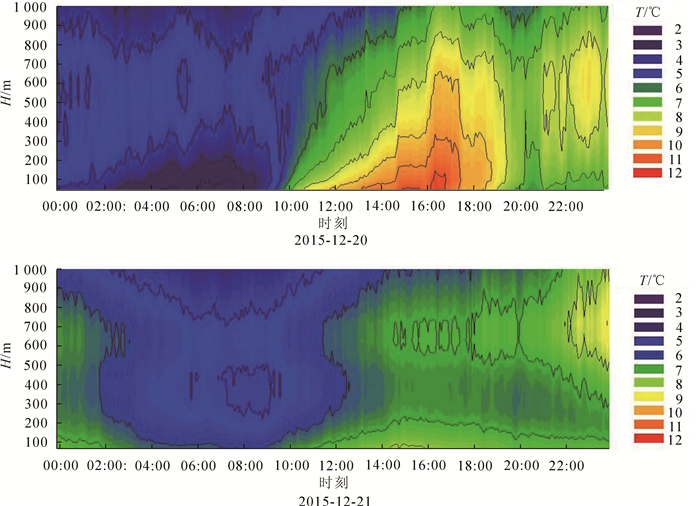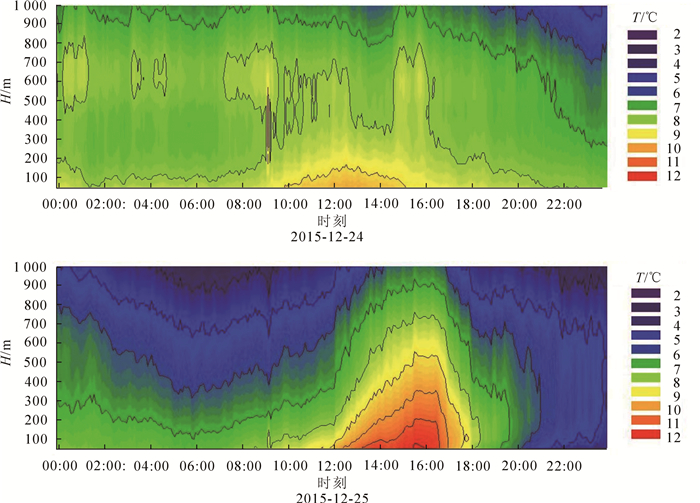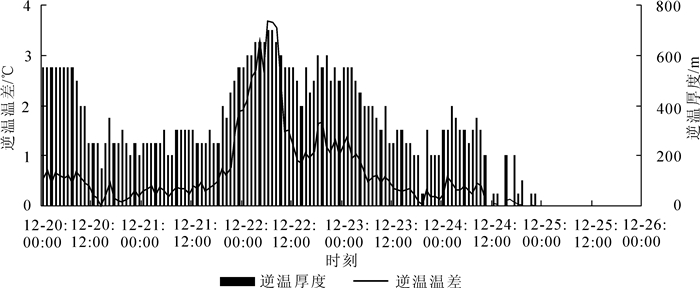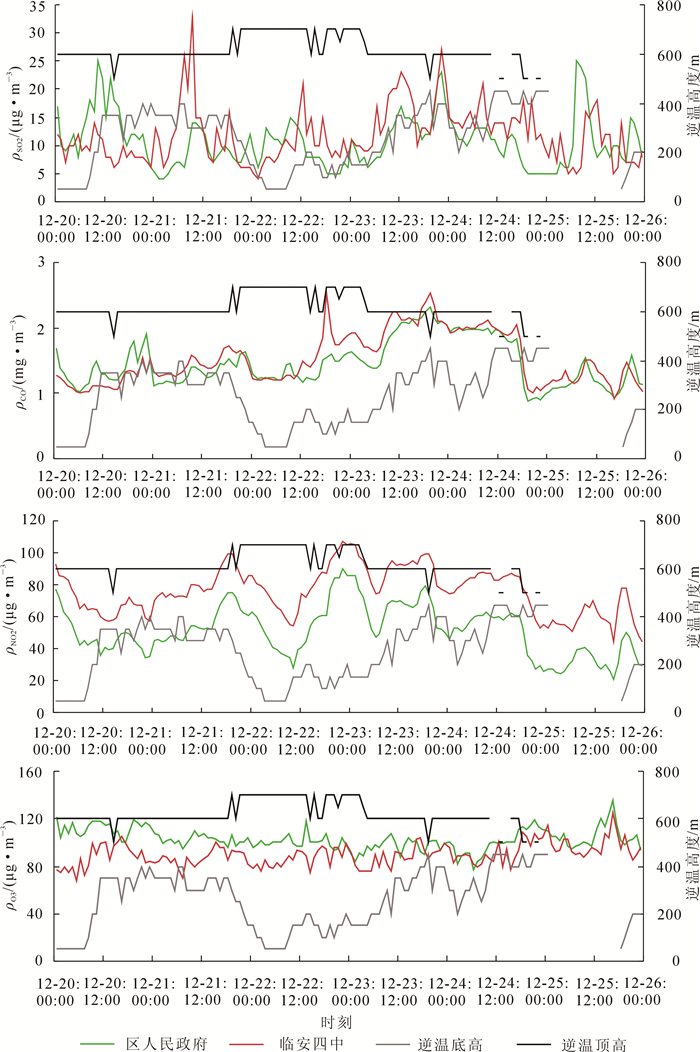-
污染事件发生与大气边界层密切相关[1-7]。20世纪初,边界层理论的提出为这一领域研究奠定了理论基础[8]。1940年,中国学者提出的湍流应力方程,丰富了大气边界层研究内容[9]。20世纪中后期,西方学者提出了局地大气边界层自由对流、大气温度层结等概念[10],陈隆勋等[11]提出大气边界层湍流场结构。进入21世纪,激光雷达和红外技术的运用提高了大气边界层温度研究的精度,发现区域大气污染与逆温出现导致的气流停滞有着密切关系[12-18],强而厚的逆温层和低的逆温层高度将污染物压缩至地面[19-24],可通过大气边界层温度监测为雾霾的预报提供依据[25-28]。由此,大气边界层温度与污染物的关联性成为研究热点问题[29-30]。本研究以杭州市临安区一次严重污染过程作为案例,分析期间近地大气边界层温度变化、逆温产生过程与空气污染出现的关系。
HTML
-
杭州临安(30°15′N,119°43′E),海拔100~150 m,位于浙江省西北部,隶属于杭州市。为亚热带季风性气候,盛行东南季风,年均降水量1 613.9 mm,年平均降水日158.0 d,无霜期年平均237.0 d。临安境内地势自西北向东南倾斜,北、西、南三面环山,东西100 km,南北50 km,总面积3 126.8 km2。西北、西南部山区平均海拔在1 000 m以上,东部河谷平原海拔在50 m以下,东西海拔相差1 770 m[31]。城区空气首要污染物为可吸入颗粒物(PM10)和细颗粒物(PM2.5)。二氧化硫(SO2),二氧化氮(NO2),PM10和PM2.5年日均值分别为8,31,81和45 μg·m-3。2016年空气质量优良天数为312 d,优良率85.2%。
-
空气质量数据来自中国环境监测总站“全国空气质量实时发布平台”。收集了2015年12月20-25日6 d的临安区人民政府、临安四中2个站点的PM2.5,PM10,二氧化硫(SO2),二氧化氮(NO2),一氧化碳(CO)和臭氧(O3)等逐时数值。评价标准为GB 3095-2012《环境空气质量标准》和HJ 633-2012《环境空气质量指数(AQI)技术规定(试行)》。气温数据由MTP5-HE微波遥感温度廓线仪测定,收集频率为5 min·次-1,接收数据20个·次-1,共收集温度数据34 560个。其工作原理是由一个辐射仪和微波吸收天线,分别发出与吸收微波,测试微波变化,并计算出气温廓线,廓线从地面开始隔50 m测得1个气温数据,点直至1 000 m高处,整个过程由全功能软件完成。
主要运用统计学中的时间序列分析方法,对测量期间从地面至1 000 m高空中气温变化情况进行分析。由于气温数据量大,采用计算机程序识别逆温状态,筛选出相应特征数据,并通过数据格式转化找出逆温底高、逆温顶高以及对应的气温、逆温厚度和温差等数据。再结合对应时间段内6种污染物变化情况,寻找逆温生成过程与污染演化过程的关系。用SigmaPlot 12.5作图呈现这次严重污染期间气温廓线图。逆温层厚度:ΔH=H2-H1,其中:H1和H2分别为逆温层底高、顶高(m);逆温层温度差:ΔT=T2-T1,其中T1和T2分别为逆温层底部、顶部温度(℃)[32]。
1.1. 研究区概况
1.2. 研究方法
-
表 1是这次大气污染过程的天气状况。主要特征是阴或小雨、低温和微风,不利于空气扩散。空气湿度大有利于氧化氮类、氧化硫类和氧化碳类气体与水分子结合生成悬浮小颗粒物。
观测日期 天气状况 T最高/℃ T最低/℃ 风向风力 2015-12-20 小雨转阴 10.0 5.0 东北风≤3级 2015-12-21 阴 12.0 6.0 东风≤3级 2015-12-22 小雨 13.0 8.0 北风≤3级 2015-12-23 阴转小雨 12.0 8.0 东北风≤3级 2015-12-24 小雨 10.0 6.0 东北风≤3级 2015-12-25 阴转多云 11.0 2.0 北风≤3级 Table 1. Weather conditions
表 2是空气质量的日变化过程。主要特征是:连续3 d轻度污染后衍化为1 d的重度污染,随后消弱至中度,之后变为良好,整个过程6 d。主要污染物为PM2.5和PM10。其他指标处在较低状态。
观测日期 空气质量指数 空气质量等级 PM2.5/(μg·m-3) PM10/(μg·m-3) SO2/(μg·m-3) CO/(μg·m-3) NO2/(μg·m-3) O3/(mg·m-3) 2015-12-20 120 轻度污染 90.9 128.8 11.4 1.278 57.9 84 2015-12-21 109 轻度污染 81.8 140 10.4 1.385 68.2 76 2015-12-22 104 轻度污染 77.1 115.5 9.5 1.418 67.1 78 2015-12-23 248 重度污染 167.9 294.8 14.1 1.955 78.2 78 2015-12-24 152 中度污染 106.9 187.6 12.1 1.717 65.1 88 2015-12-25 67 良 41.6 77.5 10.2 1.211 45.9 106 Table 2. Air quality situation
逆温可分为3个阶段,如图 1~3所示。第1阶段:逆温初始期20日21:00至21日9:00,出现拉长的逆温现象;第2阶段:21日12:00至24日18:00,持续了约40 h的逆温过程,其间22日全天出现持续逆温状态,白天地面气温与空中气温持续升高,距地面高度1 000 m范围内气温基本相同,且距离地面高度700 m处气温持续升高,20:00后距地面高度500 m以下的温度降到8.0 ℃,但700 m高度处气温依然超过10.0 ℃,出现了该次最强烈的逆温温差和最大逆温厚度。连续的逆温使得空气的扩散受阻,酿成了23日严重雾霾。第3阶段:24日20:00以后,逆温逐步消散,25日恢复正常态。
-
每日气温层结变化描述如下:20日全天温差为10.0 ℃,最高温度12.0 ℃,最低温度2.0 ℃。当天逆温主要集中在清晨和夜间2个时段。第1阶段(0:00-9:00)共经历9 h,温差小于1.0 ℃,逆温下限与上限分别为400和700 m,平均厚度为350 m。第2阶段,自21:00出现逆温状态,温差小于1.0 ℃,逆温下限与上限为300和800 m,平均厚度为450 m。
21日全天温差为5.0 ℃,最高温度为9.0 ℃,最低温度为4.0 ℃。全天逆温集中于2个时段:第1阶段(0:00-3:00)共经历3 h,温差小于0.5 ℃,逆温下限与上限处于400和900 m,平均厚度300 m。该阶段内800 m以上温度低于5.0 ℃,200 m以下平均气温度7.0 ℃。第2阶段自14:00以后,温差小于0.5 ℃,逆温厚度不足100 m。18:00起逆温高度处于550~750 m,逆温厚度超过200 m,温差平均为0.8 ℃。20:00后逆温范围不断扩大,逆温厚度逐渐增加,逆温中心温度超过9.0 ℃。
22日全天出现逆温现象,温差为7.0 ℃,最高温度13.0 ℃,最低温度6.0 ℃。0:00-6:00时间段内,200 m以下平均气温7.0 ℃,700 m处气温10.0 ℃。8:00-16:00距地面高度200 m处气温逐渐升高,平均气温12.0 ℃。700 m处气温自7:00以后超过11.0 ℃且不断升高,逆温厚度从50 m增加到500 m,温差最高达4.0 ℃。10:00-17:00距地面1 000 m高度内气温基本相同且超过11.0 ℃,全过程温差超过1.0 ℃。17:00-19:00地面气温不断下降且低于10.0 ℃,700 m处气温仍高于12.0 ℃且气温不断降低。19:00后700 m处温度逐渐低于12.0 ℃,逆温厚度逐渐减小为200 m,1 h后距地面高度200 m处气温下降至10.0 ℃,700 m处气温下降至11.0 ℃,范围继续缩小。
23日全天存在逆温现象,温差为5.0 ℃,最高气温11.0 ℃,最低气温6.0 ℃。1:00-4:00近地面温度10.0 ℃,距地面高度700 m气温11.0 ℃。4:00-12:00时间段内300和700 m高度处气温均不断下降,并依然存在温差超过2.0 ℃的逆温现象。12:00后近地面温度开始逐渐升高至11.0 ℃。700 m处气温也开始升高到10.0 ℃。20:00以后距地面200 m以上区域的气温下降至8.0 ℃,200 m以下范围内气温下降至9.0 ℃。
24日全天温差为6.0 ℃,最高气温10.0 ℃,最低气温4.0 ℃,逆温时段主要集中在11:00前。0:00-8:00距地面高度100 m处气温为8.0 ℃,600~700 m处平均气温8.0 ℃,200~500 m处平均气温7.0 ℃,逆温厚度100 m,温差小于1.0℃。8:00-14:00距地面100 m处气温逐渐升高至10.0 ℃,700 m处气温为8.0 ℃,600 m处个别时段出现气温为10.0 ℃。25日未出现明显逆温现象,温差为8.0 ℃,最高气温12.0 ℃,最低气温4.0 ℃。
-
图 4为2015年12月20-25日临安区逐时逆温温差与逆温厚度变化情况。逆温厚度最大值为700 m,平均逆温厚度为359.9 m。逆温温差最大值为3.68 ℃,平均逆温为0.71 ℃。逆温温差最大值与逆温厚度最大值均出现在22日8:00。逆温温差与逆温厚度存在极显著相关(R2=0.914,P<0.01)。
-
图 5呈现的是这一过程中临安区人民政府和临安四中2个测点逐时PM2.5和PM10质量浓度与逆温高度变化情况。逆温过程特征为:20日逆温顶高平均高度为600 m,逆温底高从距离地面50 m上升至300 m,全天2种颗粒物质量浓度变化不大。21日18:00后逆温顶高距地面高度由600 m上升至700 m,逆温底高从300 m下降至50 m。22日逆温顶高平均高度700 m,逆温底高平均高度150 m。23日1:00逆温顶高下降为距地面600 m,逆温底高从距离地面150 m上升至450 m,伴随逆温底高上升2种颗粒物质量浓度不断升高。20:00后逆温底高逐渐下降至距地面200 m,2种污染物质量浓度波动下降。24日16:00时后逆温逐渐消散;25日基本不存在逆温现象,2种颗粒物质量浓度处于较低水平。
从污染角度看,PM2.5和PM10的发生随逆温而来,又随逆温消散而去,并且伴随逆温过程而积累。PM2.5的变化特征是:总体处在24 h平均75 μg·m-3二级国家标准之上。20-22日夜间PM2.5的空气质量分指数(IAQI)为150,个别时段指数达到200,凌晨和傍晚指数相对较高;23日污染质量浓度达到全过程峰值,临安四中站为284 μg·m-3,区人民政府站为259 μg·m-3,25日迅速下降至50 μg·m-3以下。
PM10的变化特征是:2个测点的质量浓度变化相差不大,总体处在24 h平均150 μg·m-3二级国家标准之上。20-22日空气质量分指数为150~200,夜间达200。之后2个测点质量浓度波动上升,23日达到整个过程峰值,临安四中站为389 μg·m-3,区人民政府站为395 μg·m-3,25日迅速下降至100 μg·m-3以下。
图 6呈现的是临安区人民政府和临安四中2个测点逐时气体污染物质量浓度与逆温高度变化情况。20日中午临安区人民政府站二氧化硫质量浓度达到当日峰值25 μg·m-3,临安四中站为14 μg·m-3,25日19:00临安区人民政府站出现峰值25 μg·m-3,整个过程二氧化硫质量浓度均低于国家24 h平均50 μg·m-3的一级标准。在一天中早晨质量浓度逐渐升高,中午达到峰值,夜晚降低。
一氧化碳质量浓度在22日23:00达全过程峰值,临安区人民政府站为1.6 mg·m-3,临安四中站为2.5 mg·m-3。23日19:00临安区人民政府站出现峰值为2.3 mg·m-3,临安四中站点为2.5 mg·m-3。全过程在国家一级标准内。
二氧化氮质量浓度21日19:00到达全天峰值,临安区人民政府站为75 μg·m-3,临安四中站为99 μg·m-3。22日18:00临安区人民政府站和临安四中站质量浓度分别为71和105 μg·m-3。全过程在国家一级标准内。
2个站臭氧质量浓度变化差异较大,临安四中站平均值优于临安区人民政府站;整个阶段内变化幅度较大。白天出现峰值,夜间降低,全过程在国家一级标准内。
临安四中站PM10质量浓度与逆温底高极显著相关(R2=0.326,P<0.01),PM2.5质量浓度与逆温底高显著相关(R2=0.101,P<0.05);临安区人民政府站PM10质量浓度与逆温底高显著相关(R2=0.177,P<0.05),PM2.5质量浓度与逆温底高显著相关(R2=0.194,P<0.05)。PM2.5和PM10质量浓度与逆温底高变化基本一致。逆温底高下降使得垂直方向上颗粒物不容易扩散,大量颗粒物聚集造成了严重空气污染事件发生。该结论与杜荣光等[13]和简根梅等[15]结论一致。逆温顶高高度为550~700 m且变化不明显,逆温顶高与2个测站PM2.5和PM10质量浓度不存在显著相关性。PM2.5质量浓度超过115 μg·m-3(对应IAQI为150)和PM10质量浓度超过250 μg·m-3(对应IAQI为150)。二氧化硫、一氧化碳、臭氧和二氧化氮的质量浓度平均值分别为10.7 μg·m-3(σ=4.52),1.5 mg·m-3(σ=0.35),102.7 μg·m-3(σ=8.93),51.5 μg·m-3(σ=15.65)。全过程中前3种气体污染物质量浓度均低于空气质量分指数50对应的质量浓度值150 μg·m-3,5 mg·m-3和160 μg·m-3,二氧化氮质量浓度除个别时间点外也均低于100 μg·m-3(对应IAQI为50)。
2.1. 天气条件及空气质量情况
2.2. 大气温度廓线演变
2.3. 逆温温差与逆温厚度关系
2.4. 逆温高度与污染物变化
-
研究区逆温现象主要集中在清晨和傍晚,逆温底高和顶高通常为400和700 m。该次雾霾是连续3 d轻度污染后衍化为1 d的重度污染,随后消弱至中度,之后变为良好,整个过程为6 d。污染随逆温而来,又随逆温消散而去,并且伴随逆温过程而积累。
该次雾霾过程,逆温厚度最大值为700.0 m,平均逆温厚度为359.9 m。逆温温差最大值为3.7 ℃,平均逆温为0.7 ℃。逆温温差与逆温厚度极显著相关(R2=0.914,P<0.01)。
PM2.5和PM10是主要污染物,该次严重污染期间,两者质量浓度分别超过115和250 μg·m-3;二氧化硫、一氧化碳、臭氧和二氧化氮等4种气体在这次污染过程中始终处在较低的质量浓度状态。
PM2.5和PM10与逆温底高具有极显著正相关,逆温顶高与2种颗粒物质量浓度不存在显著相关。造成污染的原因是逆温底高度下降,垂直方向上颗粒物扩散受阻而产生大量聚集。













 DownLoad:
DownLoad:




